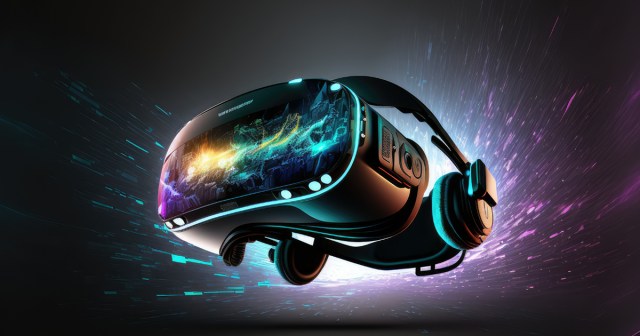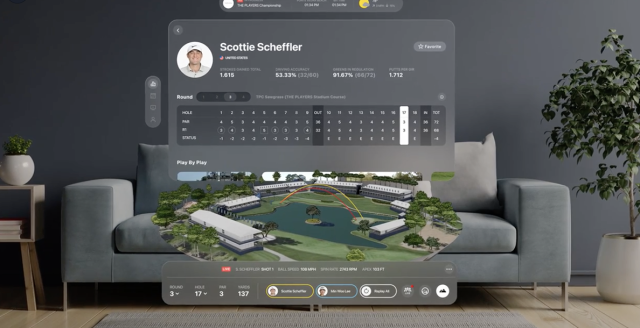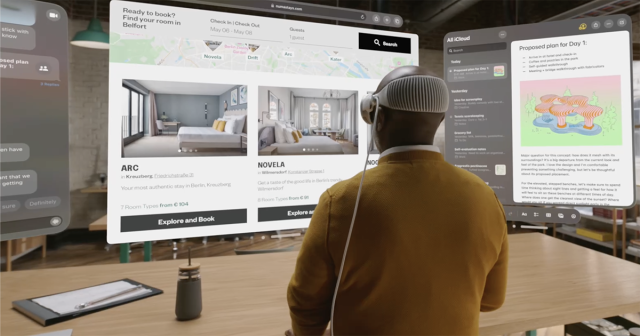
TL;DR
- No matter that Apple’s Vision Pro is lauded for having the highest fidelity visuals and most comfortable head wearing VR experience yet, no-one and not even Apple is sure what it is for.
- The biggest barrier to any new technology is figuring out the best way to use it. Apple Vision Pro offers 3D, spatial and immersive features. It’s up to early adopters to figure out the best practices, implementations, and creativity to make killer apps.
- Those companies who dive in and create spatial computing apps for the Vision Pro today give themselves a competitive advantage and position themselves as a leader in their industry.
When Apple’s Vision Pro was released, dozens of brands had lined up to experiment with native applications written in the operating system dubbed visionOS. It’s early, but none appears to be the revolution in immersive content that some have heralded.
As Scott Simmons bluntly put it in his review of the headgear on the Art of the Frame podcast: “The killer app that will make the masses strap this thing onto their face doesn’t exist right now.”
Nonetheless, these apps do give us a glimpse into how spatial computing could change business, customer service, entertainment, and work.
First, note that Simmons finds little use in working with nonlinear editors Final Cut or Adobe Premiere Pro in the new 3D environment.
“Why would I ever want to do that in the Vision Pro when I’ve got two giant monitors right here on my desktop? I can see no benefit of an app like that in the Vision Pro. Maybe that’s not what it’s really meant to be for. I still go back to the fact that you’ve got to put this thing on your head. And it’s always going to be a niche product because [of this].”
For Apple, too, the Vision Pro is also about testing the waters.
The company wouldn’t expect the first version of the system to fly off the shelves (certainly not with a $3500 price tag). But everyone expects that price to at least halve in the future — not to mention for Apple to develop a product that is more comfortable, less obtrusive and has a longer battery life; then, there will be wider consumer acceptance. (Do we even want that to happen?)
Also on The Art of the Frame, Katie Hinsen likens the product to the iPod before the iPhone: “It wasn’t quite the thing. And I don’t think Vision Pro is the thing for the mass market. I mean, they had to build whole factories just to build each individual custom part just for this thing. But it is the thing that allows us to start figuring out what we’re going to do with it. And people are going to start building apps, start building content. And I think by version three, we’re going to start seeing what the thing’s going to look like.”
Upgraded Digital Experiences
Home improvement firm Lowe’s is among the first to introduce a native Vision Pro app. It uses the illusion of depth experienced by the headset’s wearers to “walk around” properties they might like to own. In a sense, this is nothing particularly new, since virtual reality tours have featured prominently in niche real estate marketing, particularly at the luxury end of the market, for years.
Another app, made by golf’s PGA Tour, includes a 3D spatial map of the par-3 seventh hole at Pebble Beach. The app uses 2D video and 3D-rendered models generated from real-time live-shot data captured during a tournament.
VR would seem ideal for fans at home to better experience the topography of a golf course and how pros play shots, but it’s not as if these golf apps haven’t been tried before. “We were able to take the learnings from past AR/VR/XR experiences and put them into practice with PGA Tour Vision,” said Eric Hanson, PGA vice president of digital product development, in a press release.

Hinsen predicts similar experiences are in the works for concert movies. With Disney+ available on Vision Pro, users could soon watch Taylor Swift’s Era’s Tour concert video; imagine if the tour were recaptured using volumetric (depth-based) cameras!
“People have been investing in live entertainment, not just sports, but also concerts, and with volumetric capture, for this ability to really be immersed,” Hinsen says.
Now, how much would fans pay to be in the front row — albeit virtually? “Would you pay $100 to be at the front row of a Taylor Swift concert? Or a F1 Grand Prix? Or an NBA game?” Hinsen wonders.
Ad(app)ting to visionOS
As reported by Cathy Hackl in Harvard Business Review, adapting regular iOS apps to the Apple Vision Pro from mobile “is no simple task.” Apple offers a new platform, visionOS Simulator, to develop apps for the Vision Pro; developers have the option to develop in windows, volumes, or spaces.
“This creates an all-new dimension for developers to consider when creating applications for the Vision Pro,” says Hackl.

But there are challenges. These range from designing for hand-gesture input all the way to gaps in team-based knowledge. And as far as hardware, developers will need a Macbook Pro with at least an M2 Apple Silicon chip — not to mention the cost of the Vision Pro itself.
“Companies will need to decide whether they’re ready to embrace native 3D, spatial content, and whether investing in an app for the first Apple spatial computing device will be a net benefit for R&D,” Hackl says.
Risks and Potential In-App Rewards
Apple projected it could sell 350,000 VPro units in 2024, but that’s nothing compared to the 200 million iPhones it sells annually. (So how does Apple justify the product’s business case?)
Hackl says the upfront costs and investment in development teams should be considered when choosing to plan, develop, and market an app for the Vision Pro.
As with any new technology, early adopters can get a head start in learning what works — and how it works — and stand a chance to gain market share on the new platform.
But even Hackl, an advocate for Apple’s product, says “businesses who wait and learn from the first iteration of the Vision Pro may make up for a later entry with established best practices, seasoned developers, and a larger user base of Vision Pro owners.”
She also warns against platform lock-in. “Developing an app exclusively for VisionOS could mean the app is locked into the Apple ecosystem. Other head-mounted displays like the Meta Quest exist and say they will slowly start supporting spatial video, but rollout for support might be slow. Business professionals should consider where their target audience is and where they will start to migrate to.”
Over time, perhaps key audiences will be on multiple devices and spatial computing experiences may become cross-platform.
That’s a lot of “Ifs.” A wait-and-see approach seems advisable.
More About Apple’s Vision Pro
- How Apple Makes the “Business Case” for Vision Pro
- Apple Vision Pro’s Proposition: Live in a Digital World, Not the Real One
- The Vision Pro Is One Step Removed From Reality — Is That a Bad Thing?

